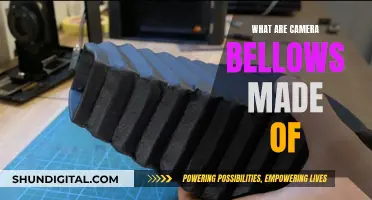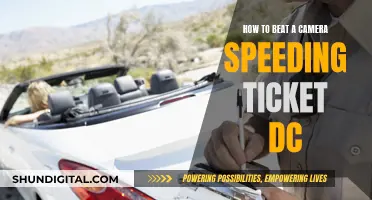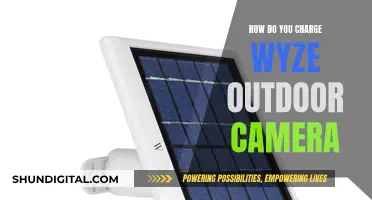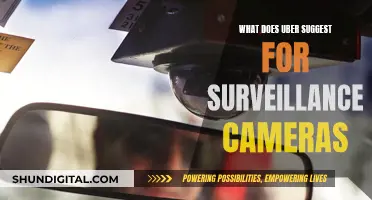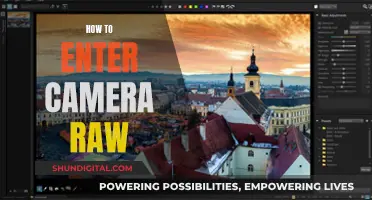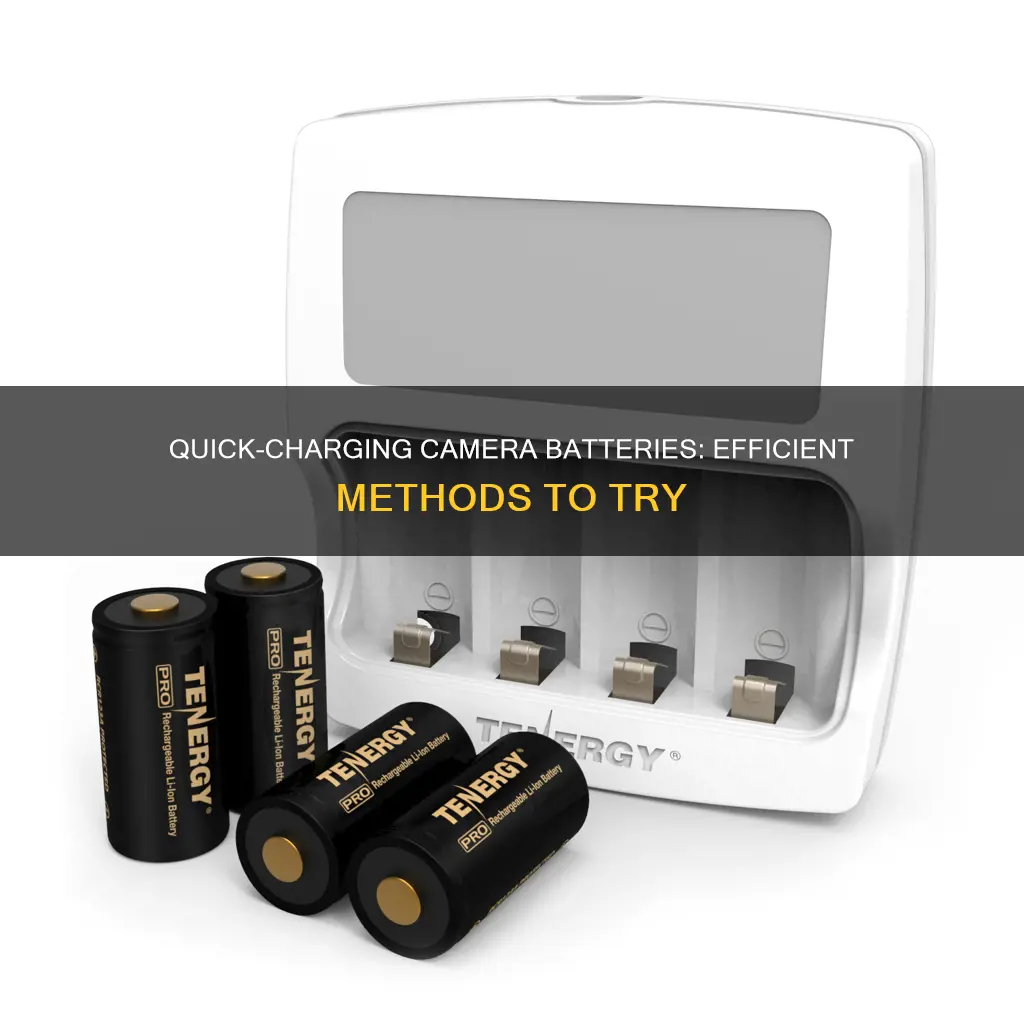
Charging a camera battery is a crucial concern for every photographer. The most common way to charge a camera battery is to use the cable with the compatible plug to attach to the camera output port socket and then plug the charging cable into a wall socket. The charging time may vary depending on the remaining capacity of the battery pack and the charging conditions. One way to charge a camera battery faster is to use an external power source such as a v-mount battery or a power bank. Another way to reduce charging time is to have multiple chargers and batteries so that you can charge them simultaneously.
| Characteristics | Values |
|---|---|
| Charging method | In-camera, external charger |
| Charging cable | USB-C, Micro USB, Mini USB |
| Power source | Wall plug, power bank, computer, car USB outlet |
| Charging time | 2-4 hours |
| Charging temperature | 10°C to 30°C (50ºF to 86ºF) |
What You'll Learn

Use a USB cable to charge your camera battery
Using a USB cable is a simple and effective way to charge your camera battery, especially when you're on the go. Here are some detailed instructions on how to use a USB cable to charge your camera battery faster:
Step 1: Turn Off Your Camera
Before you begin charging, it's important to turn off your camera completely. Charging a camera while it's powered on will take longer, so make sure to power it off first. This is applicable to both in-camera charging and charging with an external battery.
Step 2: Remove Any Accessories
If your camera has any attached accessories, such as a BacPac or MediaMod, remove them before charging. This ensures that the charging process is uninterrupted and can proceed at a faster rate.
Step 3: Find the Right USB Cable
Use the USB cable that came with your camera. This is usually included in the product package. If you don't have the original cable, refer to your camera's user manual or the manufacturer's website for recommended alternatives. Ensure that the voltage and current of the cable fit your camera's requirements.
Step 4: Connect the USB Cable
Now, you can connect your camera to a power source using the USB cable. There are several options for power sources:
- Wall Outlet: Use a USB adapter with an output of at least 5V 2A. Plug your USB cable into the adapter and then into a wall outlet.
- Power Bank: This is a convenient option when you're travelling. Simply plug your USB cable into a power bank, which can be easily carried in a backpack or placed on a table.
- Computer: You can connect your camera to a USB port on your computer. It's best to plug directly into the computer rather than using a USB hub, unless it's powered with AC. Ensure that the USB port on your computer remains powered when the computer is off.
- Car USB Outlet: Many cars come with USB ports, but they may have lower output and charge your camera slowly. Check your car user manual to see if this is an option, and look for a port with at least 5V 2A output for faster charging.
Step 5: Monitor the Charging Process
While your camera is connected and charging, keep an eye out for any indicator lights. A red LED light typically indicates that your camera is charging. Once the light turns off, your battery is fully charged and ready to use.
Additional Tips:
- Use an External Charger: Although it costs a little more, an external charger is a convenient option as it allows you to use your camera while charging a spare battery.
- Battery Maintenance: Avoid continuously charging your battery when it's already fully charged or close to full. This can lead to deterioration in battery performance over time.
- Temperature Considerations: Charge your battery within an ambient temperature range of 10°C to 30°C (50°F to 86°F). Charging may pause temporarily if the temperature is outside this recommended range.
Charging Camera Batteries: Alone Show Secrets Revealed
You may want to see also

Power off your camera before charging
Powering off your camera before charging is a crucial step in the charging process. This step is so important that it may prevent your camera from charging at all if skipped. When the camera is on, it draws power from the battery, even if it is plugged into a power source. This means that the battery will not recharge unless the camera is turned off.
Turning off your camera before charging will also help the battery recharge faster. When the camera is on, it is using up power from the battery, which means that the battery will take longer to recharge. By turning off the camera, you allow all the power from the power source to be directed towards recharging the battery.
Additionally, keeping the camera on during charging may cause the device to heat up, especially if it is in use. This is detrimental to the battery's performance and may even cause damage. It is best to ensure that the camera is turned off before plugging it into a power source to prevent this from happening.
Finally, turning off your camera before charging is a good safety practice. Forcibly cutting power to a camera that is in use could result in data loss or damage to the product's memory or internal circuitry. Therefore, it is always recommended to power off your camera before charging to avoid any accidental interruptions to the power supply.
Avoid Congestion Charges: Know Your Camera Blindspots
You may want to see also

Use a power bank to charge your camera battery
Using a power bank to charge your camera battery is a convenient way to charge your camera on the go. This method is ideal for when you are travelling or shooting outdoors and don't have access to a wall power outlet.
To charge your camera battery using a power bank, you will need a USB cable that is compatible with your camera. Most cameras come with a USB cable in the box, so you can use that. If you don't have the original cable, you can use any other universal camera battery charger suggested in the user manual or on the manufacturer's website. Make sure to check that the voltage and current of the cable are compatible with your camera.
Once you have the right cable, simply plug one end into the power bank and the other end into your camera. You can then place the power bank in your backpack or set it on a table while your camera charges.
It's important to note that charging your camera with a power bank may be slower than charging it with a wall outlet. The charging time will depend on the capacity of the power bank and the charging conditions. Additionally, some power banks may not provide enough power to charge your camera, so it's important to choose a power bank with sufficient capacity and output.
When charging your camera battery with a power bank, make sure to follow good charging habits. Ensure that your camera is turned off before connecting it to the power bank. This will allow your camera to charge faster. It is also recommended to use the original cable and charger provided by the camera manufacturer to ensure compatibility and maintain the health of your camera battery.
By following these steps and tips, you can effectively use a power bank to charge your camera battery and ensure you have a reliable power source for your camera wherever you go.
SpyPoint Camera Plans: What's the Cost of Each Camera?
You may want to see also

Use a wall plug to charge your camera battery
Using a wall plug is the most common way to charge your camera battery. Here are some detailed instructions on how to do it:
Firstly, ensure your camera is turned off. This is important because your camera may not be able to charge if it is turned on, and it will definitely take longer to charge.
Next, open the rubber cover of the camera's output port socket. This is where you will connect your charging cable. Use the cable with the compatible plug and attach it to the camera. Make sure to use the original cable that came with your camera, or another one that is recommended by the manufacturer. Check that the voltage and current of the cable are suitable for your camera.
Now, simply plug the other end of the charging cable into a wall socket. If you are using a USB cable, you will need a USB adapter to plug the cable into. The adapter should output at least 5V 2A.
At this point, your camera battery should be charging. You may see a light on your camera indicating that it is charging. Depending on the model of your camera, this could be a red or flashing light.
The time it takes to charge your camera battery will vary depending on the remaining capacity of the battery and the charging conditions. A completely discharged battery may take around 2 hours to fully recharge, but this could be longer or shorter depending on various factors. These include the ambient temperature, battery health, battery capacity, and charger type.
Once your camera battery is fully charged, be sure to unplug the charger from the wall socket. Do not leave your camera battery charging indefinitely, as this may cause a deterioration in battery performance.
Charging the Wyze Camera: Quick and Easy Steps
You may want to see also

Use a computer to charge your camera battery
Using a computer to charge your camera battery is a convenient way to power up your device, especially when you don't have access to a wall outlet. Here are some detailed instructions to help you charge your camera battery using a computer:
Step 1: Turn Off Your Camera
Before you begin charging, it is important to turn off your camera completely. Charging a camera while it is powered on will result in slower charging. So, make sure to power off your device before proceeding to the next step.
Step 2: Remove Any Accessories
If your camera has any attached accessories, such as a BacPac or MediaMod, remove them. This ensures that the charging process can focus solely on the camera battery, potentially speeding up the process.
Step 3: Connect Your Camera to the Computer
Now, take your USB cable and connect it to your camera. Most cameras will have a micro-USB or USB-C port. Once your camera is connected, plug the other end of the USB cable into one of your computer's USB ports. It is recommended to plug directly into a USB port on your computer, rather than using a USB hub, for more efficient charging.
Step 4: Ensure Your Computer is Powered On
For the charging process to work, your computer needs to be powered on. Even if the computer is asleep or in standby mode, the USB ports may not provide enough power for charging. So, make sure your computer is turned on and not in a power-saving state.
Step 5: Look for Charging Indicators
Once your camera is connected and your computer is powered on, check for any charging indicators on your camera. This could be a small LED light that turns red when charging and green when complete. Refer to your camera's user manual if you're unsure about the charging indicators.
Step 6: Allow Time for Charging
Charging times can vary depending on the remaining capacity of your battery and other factors. Generally, a camera battery can take around 2 to 4 hours to fully charge. Allow sufficient time for your battery to reach a full charge before disconnecting.
Step 7: Disconnect and Resume Usage
Once your camera battery is fully charged, you can safely disconnect the USB cable from both your camera and your computer. Now, your camera is ready to use, and you can resume capturing photos or videos with a fully charged battery.
Remember that charging a camera battery via a computer may not be as fast as using a wall outlet with a dedicated charger. However, it is a useful option when you're on the go or don't have access to a power outlet. Always refer to your camera's user manual for specific instructions and recommendations regarding charging.
Alternative Ways to Charge Your GH2 Camera
You may want to see also
Frequently asked questions
The best way to charge your camera battery faster is to use an external charger. This allows you to continue shooting with a spare battery while your dead battery charges.
You can also charge your camera battery faster by:
- Turning off your camera: Charging a powered-on camera will take longer.
- Removing any accessories: These can slow down the charging process.
- Using a high-quality cable: A high-quality cable will enable quicker charging.
- Charging at the right temperature: Charging at a temperature between 10°C to 30°C (50ºF to 86ºF) is recommended.
It usually takes around 2 hours to fully charge a camera battery. However, this may vary depending on factors such as ambient temperature, battery health, capacity, and charger type.
Yes, you can charge your camera battery using a USB cable. This is a convenient option when you don't have access to a wall power outlet. You can use a power bank, your computer, or your car's USB outlet to charge your camera battery.


